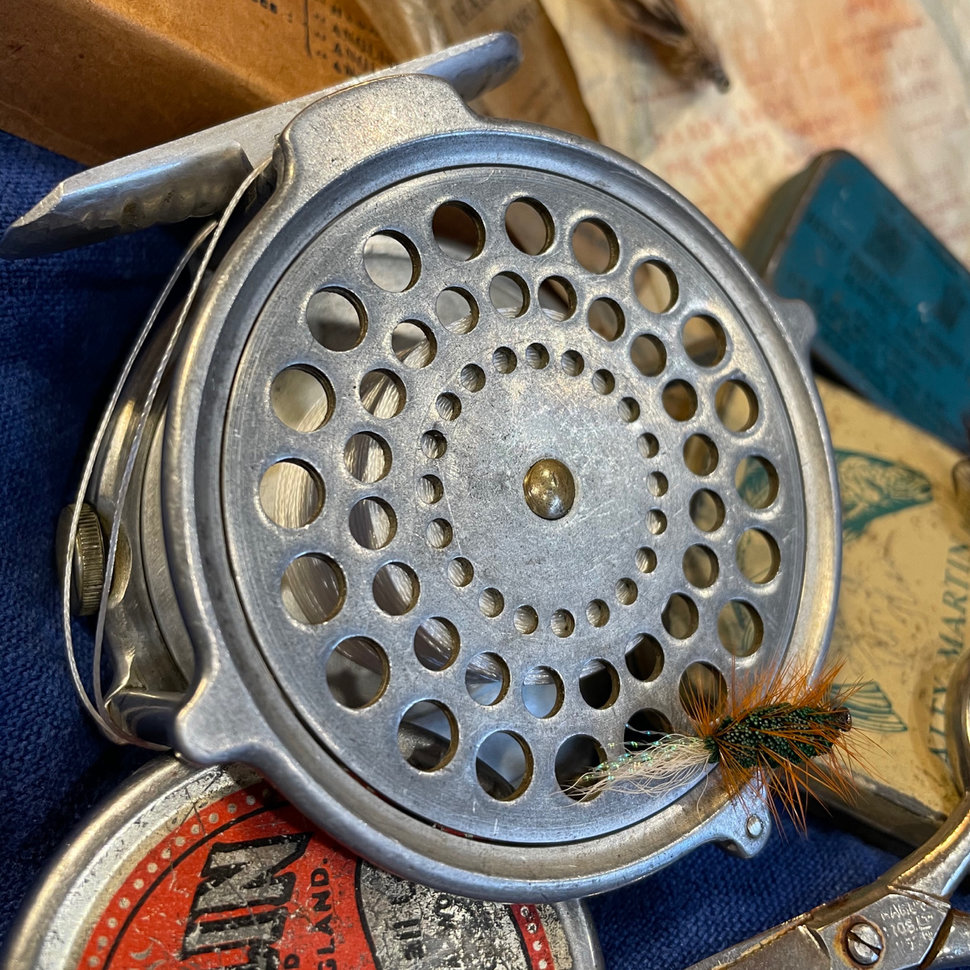The Bouglé

The Bouglé
(1903-1939 and W.W.2)
A reel as odd and charming as the maker himself, Louie Bouglé was a existential character. With a name most westerners have trouble pronouncing, the Bouglé is a time capsule of angling history exceedingly rare to find in its original form with a price tag to insure longevity for die hard collectors.
Louis Bouglé was always “Eccentrically dressed with his “porthole glasses”, his incredible cap, his Fishing basket, landing net and binoculars”. Characteristically speaking, Bouglé was one to go against the current trends, “when everyone else was donning a full mustache, his face was shaved clean”. Quote and info from John Drewetts , Hardy Brothers~ The Masters the Men & Their Reels , aka, a modern day “Bible” for us crazed with Hardy “Feva”, where the only cure is to collect more reels and insights on the subject!
I am fascinated to learn about the individuals who created and greatly influenced so many of the pieces I fish and cherish today. Early on in my collecting, I was never a huge fan of this particular Hardy model as I found myself regularly baffled as to each of the Bouglés line capacities; a 1/4” step smaller than what was actually stamped on the reel. Learning from the pages of faded, sepia toned Hardy catalogs, and hand written letters (yes, ye old pen and ink!) back and forth from this young girl to the other side of the pond, my mind was already blurred from the myriad of bits and pieces of information I had assessed which only led to more unanswered questions.
Clearly, I was not understanding the premise for how and why the frame was brought about in the first place; coupled with a price tag that was wayyy out of my price range, the Bouglé became a reel I overlooked for several decades before the light came on. Shameful, I know, but in looking back now, I see how it’s all apart of the learning curve.
For as far as I could see then, The Bouglé would just have to wait.
~~~
In 1903 Hardy first catalogued the Bouglé. Louis had approached the company to make a reel that was wide enough to balance fly rods between 4 1/2 ounces to 8 ounces with excellent line capacity. What I would do to have been a fly on the wall for these initial conversations are details I ponder in the night. The first Bouglé was only produced in a 3“ size and was lighter than a contemporary 3” Perfect by 3 1/4” oz!
Easy to identify, the Bouglé features several raised flanges that protrude from the rims of the reel and earliest models dawn a strapped tension screw. Over the years, the Bouglé was outfitted with a 1910, 1912 and Mark II check and most early models finished “in the white”, or shiny, and some later Black leaded, or bronzed; from 1939, Bouglé’s were finished with either a matte black paint or papered bright and then lacquered.
Here in lies the tricky part about measuring a Bouglé compared with a standard Perfect: Traditionally, we measure a reel across the face of the winding plate from the widest point to the widest point. However, because the four raised portions on the Bouglé that separate the roller pillars and how the foot was attached to the reel itself thus reducing the overall weight, end up measuring out at least a quarter inch larger than what the actual line capacity truly is. In other words, a Bouglé listed as 3 inch was closer to a 3 1/2” in diameter if you include the rim and the raised portions and, the reels were and are still stamped as such. Thus, a 3 3/4” Bouglé is more like a 3 1/4” wide Perfect for its line capacity.
The Bouglé was laborious to build and Hardy workers received bonus pay upon finishing each piece although it has been reported that the tip was not nearly enough for all of the extra work. The 1925-1939 Production books share with us that only a small number of reels were manufactured and we know production was paused during WWII; only a handful of reels were put together using pre-war parts. The Bouglé was never re-introduced after the war and the pieces we see today in fly shops throughout the country are mostly heritage type reproductions.
After studying about Mr. Bouglé himself, it made so much sense how the chosen material of “nickel silver, shining in the sun like a mirror of larks“, was a reflection of the man himself.
A well liked, out-of-the box thinker who was hard working and passionate, Bouglé would be extremely flattered to know how his name is infamous throughout angling history all because of his unique idea to change the iconic Perfects’ frame in order to lighten the reel. Certainly, the results are held with deep appreciation to this day and to the collectors’ gain!





Comments